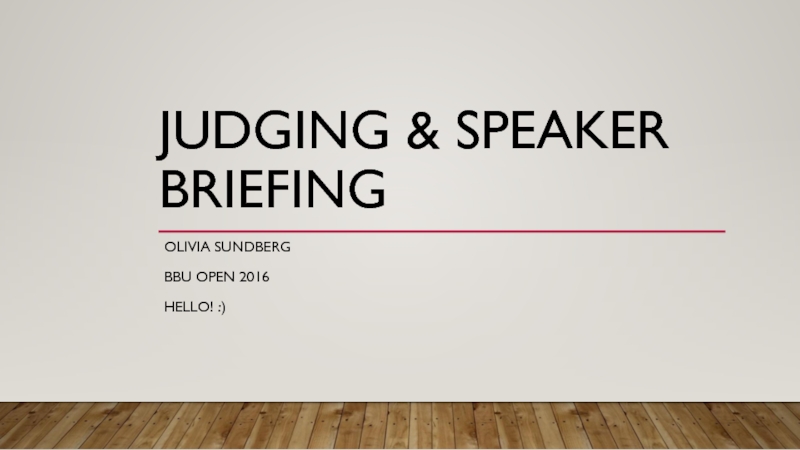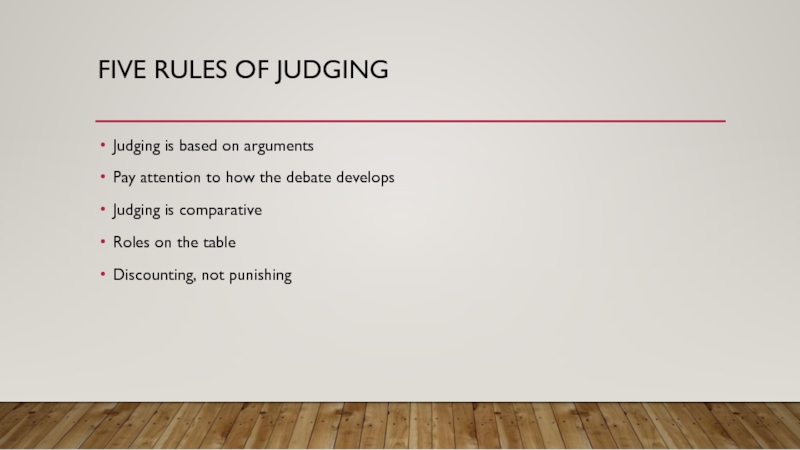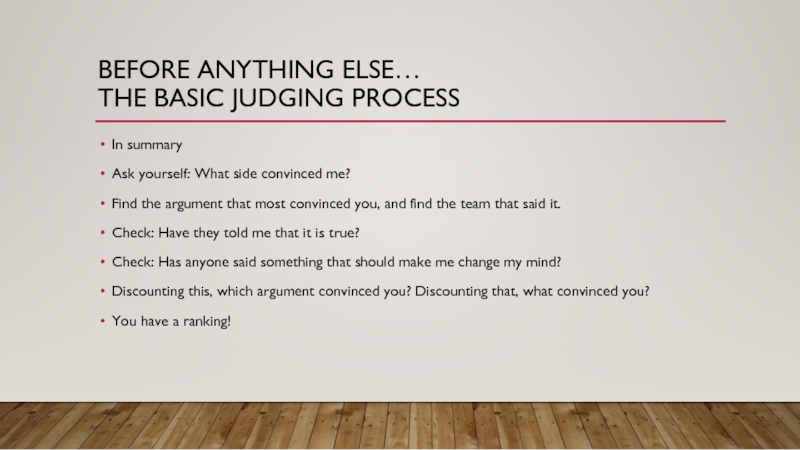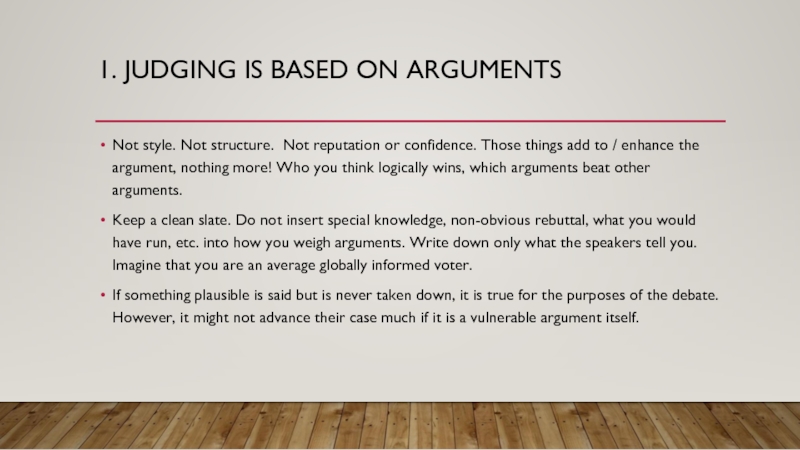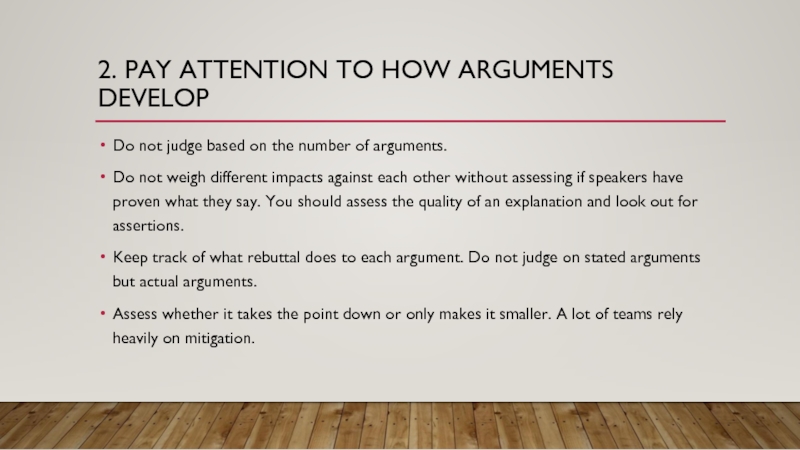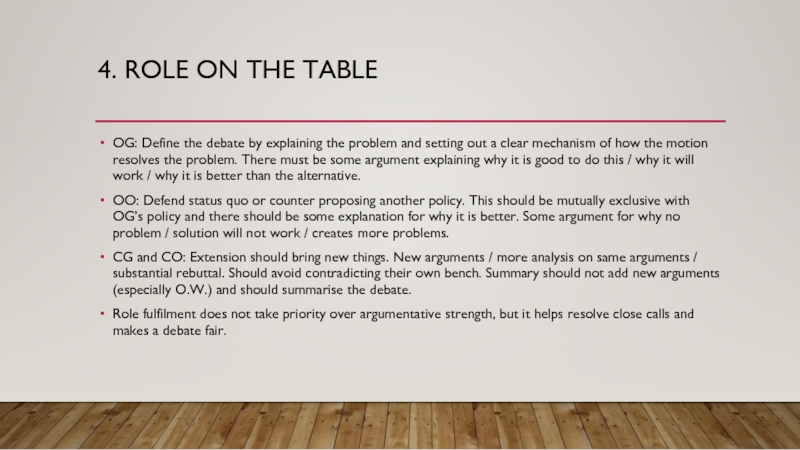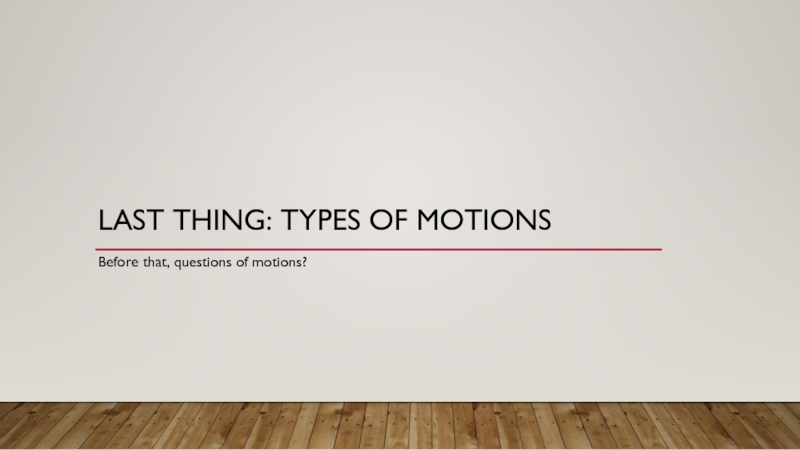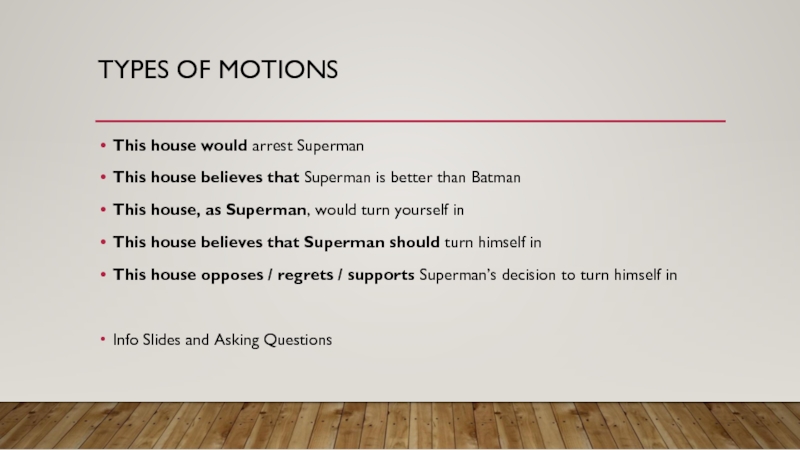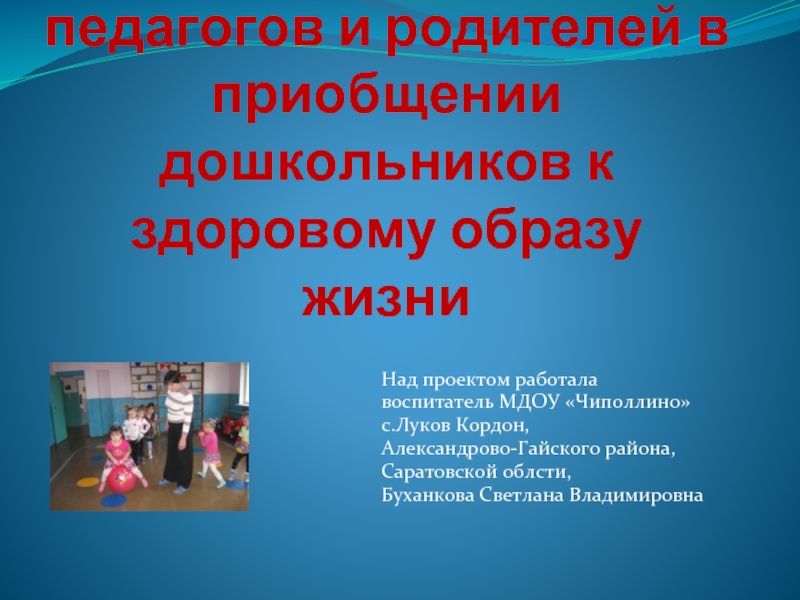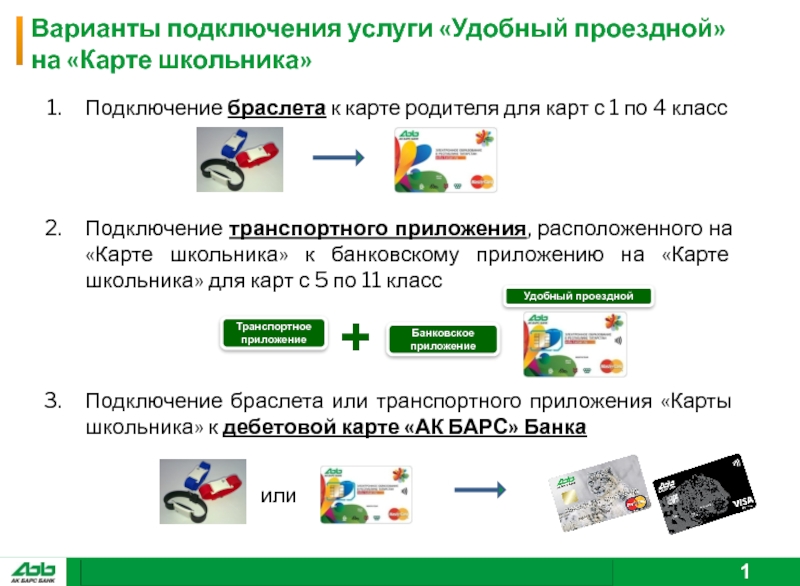- Главная
- Разное
- Дизайн
- Бизнес и предпринимательство
- Аналитика
- Образование
- Развлечения
- Красота и здоровье
- Финансы
- Государство
- Путешествия
- Спорт
- Недвижимость
- Армия
- Графика
- Культурология
- Еда и кулинария
- Лингвистика
- Английский язык
- Астрономия
- Алгебра
- Биология
- География
- Детские презентации
- Информатика
- История
- Литература
- Маркетинг
- Математика
- Медицина
- Менеджмент
- Музыка
- МХК
- Немецкий язык
- ОБЖ
- Обществознание
- Окружающий мир
- Педагогика
- Русский язык
- Технология
- Физика
- Философия
- Химия
- Шаблоны, картинки для презентаций
- Экология
- Экономика
- Юриспруденция
Judging & speaker. Briefing презентация
Содержание
- 1. Judging & speaker. Briefing
- 2. WHAT DOES JUDGING INVOLVE? Draw and motion
- 3. FIVE RULES OF JUDGING Judging is based
- 4. BEFORE ANYTHING ELSE… THE BASIC JUDGING PROCESS
- 5. 1. JUDGING IS BASED ON ARGUMENTS Not
- 6. 2. PAY ATTENTION TO HOW ARGUMENTS DEVELOP
- 7. 3. JUDGING IS COMPARATIVE Start comparing teams
- 8. 4. ROLE ON THE TABLE OG: Define
- 9. 5. DISCOUNTING, NOT PUNISHING Assertions, contradictions New
- 10. TAKING NOTES Take clear and detailed notes,
- 11. CHAIRING & GIVING FEEDBACK In the adjudication:
- 12. LAST THING: TYPES OF MOTIONS Before that, questions of motions?
- 13. TYPES OF MOTIONS This house would arrest
Слайд 2WHAT DOES JUDGING INVOLVE?
Draw and motion announced. Go to your rooms.
During
debate, chair leads the debate and all judges take notes.
Ranking teams 1-2-3-4.
After debate, take 2 minutes to look over notes and start discussing. Chair guides discussion but all judges should have input. Discuss specifically and comparatively.
Maximum 15 minutes, giving comparable time to all teams. Come to a vote if necessary.
Give the result of the debate and feedback for everyone. Take 10-15 minutes.
Teams to approach judges for individual feedback if interested.
Ranking teams 1-2-3-4.
After debate, take 2 minutes to look over notes and start discussing. Chair guides discussion but all judges should have input. Discuss specifically and comparatively.
Maximum 15 minutes, giving comparable time to all teams. Come to a vote if necessary.
Give the result of the debate and feedback for everyone. Take 10-15 minutes.
Teams to approach judges for individual feedback if interested.
Слайд 3FIVE RULES OF JUDGING
Judging is based on arguments
Pay attention to how
the debate develops
Judging is comparative
Roles on the table
Discounting, not punishing
Judging is comparative
Roles on the table
Discounting, not punishing
Слайд 4BEFORE ANYTHING ELSE…
THE BASIC JUDGING PROCESS
In summary
Ask yourself: What side convinced
me?
Find the argument that most convinced you, and find the team that said it.
Check: Have they told me that it is true?
Check: Has anyone said something that should make me change my mind?
Discounting this, which argument convinced you? Discounting that, what convinced you?
You have a ranking!
Find the argument that most convinced you, and find the team that said it.
Check: Have they told me that it is true?
Check: Has anyone said something that should make me change my mind?
Discounting this, which argument convinced you? Discounting that, what convinced you?
You have a ranking!
Слайд 51. JUDGING IS BASED ON ARGUMENTS
Not style. Not structure. Not reputation
or confidence. Those things add to / enhance the argument, nothing more! Who you think logically wins, which arguments beat other arguments.
Keep a clean slate. Do not insert special knowledge, non-obvious rebuttal, what you would have run, etc. into how you weigh arguments. Write down only what the speakers tell you. Imagine that you are an average globally informed voter.
If something plausible is said but is never taken down, it is true for the purposes of the debate. However, it might not advance their case much if it is a vulnerable argument itself.
Keep a clean slate. Do not insert special knowledge, non-obvious rebuttal, what you would have run, etc. into how you weigh arguments. Write down only what the speakers tell you. Imagine that you are an average globally informed voter.
If something plausible is said but is never taken down, it is true for the purposes of the debate. However, it might not advance their case much if it is a vulnerable argument itself.
Слайд 62. PAY ATTENTION TO HOW ARGUMENTS DEVELOP
Do not judge based on
the number of arguments.
Do not weigh different impacts against each other without assessing if speakers have proven what they say. You should assess the quality of an explanation and look out for assertions.
Keep track of what rebuttal does to each argument. Do not judge on stated arguments but actual arguments.
Assess whether it takes the point down or only makes it smaller. A lot of teams rely heavily on mitigation.
Do not weigh different impacts against each other without assessing if speakers have proven what they say. You should assess the quality of an explanation and look out for assertions.
Keep track of what rebuttal does to each argument. Do not judge on stated arguments but actual arguments.
Assess whether it takes the point down or only makes it smaller. A lot of teams rely heavily on mitigation.
Слайд 73. JUDGING IS COMPARATIVE
Start comparing teams throughout the debate – you
need to constantly assess where teams are placing in relation to each other and constantly be willing to change your mind.
Be specific: “Their arguments were good”, “they were less convincing”, “the analysis got better in second opposition” is not very useful.
Compare teams with all other teams. This is true in adjudication as well – it is not only about 1-2, 2-3, 3-4 although this is the most important.
Be fair and let them tell you what argument or metric is the most important. Do not weigh whether different stakeholders / practical or principled arguments are most important if they do not tell you.
Be specific: “Their arguments were good”, “they were less convincing”, “the analysis got better in second opposition” is not very useful.
Compare teams with all other teams. This is true in adjudication as well – it is not only about 1-2, 2-3, 3-4 although this is the most important.
Be fair and let them tell you what argument or metric is the most important. Do not weigh whether different stakeholders / practical or principled arguments are most important if they do not tell you.
Слайд 84. ROLE ON THE TABLE
OG: Define the debate by explaining the
problem and setting out a clear mechanism of how the motion resolves the problem. There must be some argument explaining why it is good to do this / why it will work / why it is better than the alternative.
OO: Defend status quo or counter proposing another policy. This should be mutually exclusive with OG’s policy and there should be some explanation for why it is better. Some argument for why no problem / solution will not work / creates more problems.
CG and CO: Extension should bring new things. New arguments / more analysis on same arguments / substantial rebuttal. Should avoid contradicting their own bench. Summary should not add new arguments (especially O.W.) and should summarise the debate.
Role fulfilment does not take priority over argumentative strength, but it helps resolve close calls and makes a debate fair.
OO: Defend status quo or counter proposing another policy. This should be mutually exclusive with OG’s policy and there should be some explanation for why it is better. Some argument for why no problem / solution will not work / creates more problems.
CG and CO: Extension should bring new things. New arguments / more analysis on same arguments / substantial rebuttal. Should avoid contradicting their own bench. Summary should not add new arguments (especially O.W.) and should summarise the debate.
Role fulfilment does not take priority over argumentative strength, but it helps resolve close calls and makes a debate fair.
Слайд 95. DISCOUNTING, NOT PUNISHING
Assertions, contradictions
New material in summary, bad teamwork
Bad time
management or bad structure
No points of information offered or accepted – indication that there is no rebuttal.
All of these things should be discounted in their respective areas, but you should not penalise teams for saying them. We use “positive marking” – you can signal this difference in the speaker points. Speaker points are for cleverness and originality.
No points of information offered or accepted – indication that there is no rebuttal.
All of these things should be discounted in their respective areas, but you should not penalise teams for saying them. We use “positive marking” – you can signal this difference in the speaker points. Speaker points are for cleverness and originality.
Слайд 10TAKING NOTES
Take clear and detailed notes, so you can refer to
them in adjudication. Exact quotes are good.
Two or three colours – one for notes, one for feedback / criticism / gaping holes. Make POIs distinguishable.
Draw arrows for rebuttal or clashes. Draw arrows and question marks for missing rebuttal.
Can make notes on structure, timing, etc. This should not be rigid or a source of punishment insofar as it does not harm your understanding of their arguments.
2 pages of 4 boxes; another page with the main points of each team.
Two or three colours – one for notes, one for feedback / criticism / gaping holes. Make POIs distinguishable.
Draw arrows for rebuttal or clashes. Draw arrows and question marks for missing rebuttal.
Can make notes on structure, timing, etc. This should not be rigid or a source of punishment insofar as it does not harm your understanding of their arguments.
2 pages of 4 boxes; another page with the main points of each team.
Слайд 11CHAIRING & GIVING FEEDBACK
In the adjudication: Take calls, structure the discussion
(one comparison at a time), everyone should have a say, take notes of the discussion from the wings. If winging: Say a lot but don’t obstruct the chat
In the adjudication: Ensure that all teams and comparisons are given fair consideration (e.g. put words to consensus calls, 1st-2nd and 3rd-4th deserve equal time)
Reaching a call: Respect deadlines (leaving time for speaks), call a vote when necessary
Giving feedback: Give all teams equal time, structure it by comparisons or chronologically, use notes from adjudication chat to include wings, explain ALL clashes and comparisons, general coaching is useful, “What I Would Have Run” is not
Giving feedback: Mention any equity issues if appropriate, reserve individual feedback for after the call, encourage individual feedback and make yourself available!
In the adjudication: Ensure that all teams and comparisons are given fair consideration (e.g. put words to consensus calls, 1st-2nd and 3rd-4th deserve equal time)
Reaching a call: Respect deadlines (leaving time for speaks), call a vote when necessary
Giving feedback: Give all teams equal time, structure it by comparisons or chronologically, use notes from adjudication chat to include wings, explain ALL clashes and comparisons, general coaching is useful, “What I Would Have Run” is not
Giving feedback: Mention any equity issues if appropriate, reserve individual feedback for after the call, encourage individual feedback and make yourself available!
Слайд 13TYPES OF MOTIONS
This house would arrest Superman
This house believes that Superman
is better than Batman
This house, as Superman, would turn yourself in
This house believes that Superman should turn himself in
This house opposes / regrets / supports Superman’s decision to turn himself in
Info Slides and Asking Questions
This house, as Superman, would turn yourself in
This house believes that Superman should turn himself in
This house opposes / regrets / supports Superman’s decision to turn himself in
Info Slides and Asking Questions
